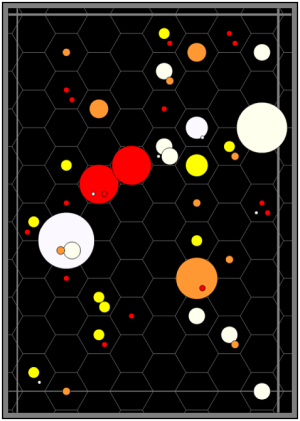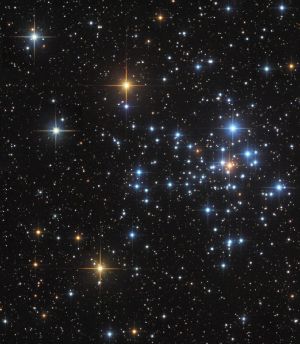Difference between revisions of "Banderhue Subsector"
| (16 intermediate revisions by 3 users not shown) | |||
| Line 21: | Line 21: | ||
[[Banderhue Subsector]] is [[Subsector]] D of [[Theta Borealis Sector]]. | [[Banderhue Subsector]] is [[Subsector]] D of [[Theta Borealis Sector]]. | ||
* It lies within [[Charted Space]]. | * It lies within [[Charted Space]]. | ||
| + | * On older surveys it may be referred to as the ''Banderhue Quadrant''. | ||
__TOC__ | __TOC__ | ||
| Line 39: | Line 40: | ||
* Its precise location, nature, and characteristics remain unknown. | * Its precise location, nature, and characteristics remain unknown. | ||
** It is believed to lie across parts of [[Monway Subsector]] and Banderhue Subsector. | ** It is believed to lie across parts of [[Monway Subsector]] and Banderhue Subsector. | ||
| + | |||
| + | ==== Thetan Void ==== | ||
| + | The Thetan Void is a [[Rift|rift region]] of very low stellar density. | ||
| + | * The Void primarily lies within [[Sibigil Subsector]], with its fringes just within [[Monway Subsector]], Banderhue Subsector, and [[Phoenix Subsector]]. | ||
| + | * The Void measures around [[Parsec|10 parsecs]] [[spinward]]-[[trailing]] by around [[Parsec|8 parsecs]] [[coreward]]-[[rimward]]. | ||
| + | * It is a significant barrier to [[Jump Drive|interstellar travel]] | ||
| + | * It serves as a natural line of defense for the [[Trooles Confederation]] against the [[Korsumug Empire]]. | ||
| + | * Its spinward end is known as the ''Korsumug Gate''. | ||
==== Borealis Group ==== | ==== Borealis Group ==== | ||
The subsector forms part of the ''Borealis Group'', a gigantic, broadly spherical [[cluster]] of stars centered on [[Theta Borealis Sector]]. | The subsector forms part of the ''Borealis Group'', a gigantic, broadly spherical [[cluster]] of stars centered on [[Theta Borealis Sector]]. | ||
| − | * | + | * It is a distinctive, extremely [[Astrographic Feature|bright feature]] that can be easily observed from all across [[Charted Space]]. |
| + | * It is more than [[Parsec|40 parsecs]] in diameter. | ||
* It contains an unusually high number of [[Star|giant stars]]. | * It contains an unusually high number of [[Star|giant stars]]. | ||
| − | * | + | * It is the density of giant stars within the region, rather than their individual brightness, that makes [[Astrographic Feature|the feature]] so prominent. |
| − | + | ||
| + | [[File:Theta Borealis Bright Stars 2.jpg|300 px]] | ||
| − | + | The night-time skies of all of the worlds across the region are studded with a panoply of colorful, intensely bright stars. | |
| − | The intensely bright | + | * Some are so bright that they can be clearly seen from planetary surfaces during daylight hours. |
* The brightest is [[Muravia (world)|''Theta Borealis'']], an unstable, violent, blue-white bright supergiant with a luminosity of around 73,000 sols. | * The brightest is [[Muravia (world)|''Theta Borealis'']], an unstable, violent, blue-white bright supergiant with a luminosity of around 73,000 sols. | ||
| − | * | + | * Other extremely bright stars within the [[cluster]] include [[Pyremide (world)|''Sigma Borealis'']], [[Ugnes (world)|''Tau Borealis'']], [[Farbel (world)|''Epsilon Borealis'']], [[Murtaskin (world)|''Mu Borealis'']], and [[Apsheron (world)|''Kappa Borealis'']]. |
| − | * While the | + | * While the [[cluster]] contains many extremely luminous giant stars, Theta B is exponentially brighter than any of the others. |
| − | [[ | + | Chains of giant stars trail out from the [[cluster]] into many of the surrounding sectors. |
| + | * Banderhue Subsector lies to [[coreward]]-[[trailing]] of the [[cluster]]s core, forming part of a long outlying trail of giant stars. | ||
==== Stellar Distribution ==== | ==== Stellar Distribution ==== | ||
| Line 99: | Line 111: | ||
* [[Non-Human Race]]s | * [[Non-Human Race]]s | ||
| − | ** | + | ** [[Captutian]] of [[Nithus (world)|Nithus]] |
| + | ** [[Cygmo]] of [[Sapies (world)|Sapies]] | ||
| + | ** [[Mitzene]] of [[Sapies (world)|Sapies]] | ||
| + | ** [[Bose]] of [[Wabor-Parn (world)|Warbor-Parn]] | ||
| + | ** [[Trist]] of [[Wabor-Parn (world)|Warbor-Parn]] | ||
* [[Terragen]]s (Non-human [[Terran]] races) | * [[Terragen]]s (Non-human [[Terran]] races) | ||
| Line 127: | Line 143: | ||
|S2= {{Ludography cite|name= Theta Borealis Sector |page= TBD}} | |S2= {{Ludography cite|name= Theta Borealis Sector |page= TBD}} | ||
|S3= {{Ludography cite|name= Solomani & Aslan |page=11,50}} (dot map provided) | |S3= {{Ludography cite|name= Solomani & Aslan |page=11,50}} (dot map provided) | ||
| − | + | ||
|S5= Author & Contributor: [[Jo Grant]] of [[CORE]] (generated data) | |S5= Author & Contributor: [[Jo Grant]] of [[CORE]] (generated data) | ||
| − | + | ||
}} | }} | ||
| − | + | [[Category: Guidebook to Theta Borealis Sector]] | |
{{LE|T5 Second Survey|}} | {{LE|T5 Second Survey|}} | ||
Latest revision as of 09:23, 20 March 2024
| Banderhue Subsector | ||||||
|---|---|---|---|---|---|---|
| ||||||
| Sector | Theta Borealis | |||||
| Capital | None | |||||
| No. of Stars | 34 | |||||
| Majority Control | Non-Aligned (NaHu) - 100% | |||||
Banderhue Subsector is Subsector D of Theta Borealis Sector.
- It lies within Charted Space.
- On older surveys it may be referred to as the Banderhue Quadrant.
Description (Specifications)[edit]
No information yet available.
World Details: 1105[edit]
Detailed UWP data for all the worlds listed within the subsector can be retrieved from Theta Borealis Sector data files.
- The first listed world lying within the subsector occupies hex 2506.
- The last listed world lying within the subsector occupies hex 3210.
Astrographic Features & Trade Routes: 1105[edit]
The following astrographic and commercial data has been determined:
Uncharted Anomaly[edit]
The "Enigma of Theta Borealis" is a mysterious astrographic feature.
- It is believed to be an uncharted space-time anomaly
- Its precise location, nature, and characteristics remain unknown.
- It is believed to lie across parts of Monway Subsector and Banderhue Subsector.
Thetan Void[edit]
The Thetan Void is a rift region of very low stellar density.
- The Void primarily lies within Sibigil Subsector, with its fringes just within Monway Subsector, Banderhue Subsector, and Phoenix Subsector.
- The Void measures around 10 parsecs spinward-trailing by around 8 parsecs coreward-rimward.
- It is a significant barrier to interstellar travel
- It serves as a natural line of defense for the Trooles Confederation against the Korsumug Empire.
- Its spinward end is known as the Korsumug Gate.
Borealis Group[edit]
The subsector forms part of the Borealis Group, a gigantic, broadly spherical cluster of stars centered on Theta Borealis Sector.
- It is a distinctive, extremely bright feature that can be easily observed from all across Charted Space.
- It is more than 40 parsecs in diameter.
- It contains an unusually high number of giant stars.
- It is the density of giant stars within the region, rather than their individual brightness, that makes the feature so prominent.
The night-time skies of all of the worlds across the region are studded with a panoply of colorful, intensely bright stars.
- Some are so bright that they can be clearly seen from planetary surfaces during daylight hours.
- The brightest is Theta Borealis, an unstable, violent, blue-white bright supergiant with a luminosity of around 73,000 sols.
- Other extremely bright stars within the cluster include Sigma Borealis, Tau Borealis, Epsilon Borealis, Mu Borealis, and Kappa Borealis.
- While the cluster contains many extremely luminous giant stars, Theta B is exponentially brighter than any of the others.
Chains of giant stars trail out from the cluster into many of the surrounding sectors.
- Banderhue Subsector lies to coreward-trailing of the clusters core, forming part of a long outlying trail of giant stars.
Stellar Distribution[edit]
A basic map showing the distribution and size of stars within Banderhue Subsector.
- The color corresponds to the visible color of the star, which links to its spectral classification.
- The size as shown indicates both the physical size of the object and its relative brightness.

(Chart sourced from Traveller Map).
Note that the stars as depicted are representative. Any star, no matter what its size, is a mere speck within the hex it occupies.
- Ordinary main sequence stars can barely be seen from even a hex away.
- Huge, intensely luminous giant stars can be seen from across the subsector and far beyond.
World Listing: 1105[edit]
The following systems and worlds can be found within this area:
Subsector Summary: 1105[edit]
Banderhue, subsector D of Theta Borealis contains 34 worlds with an estimated population of 46 billion, a per capita income of Cr5,804, and a total economy is BCr271,202. These worlds originate an interstellar trade of BCr189 through 26 starports (7 Class A, 9 Class B, 9 Class C, 1 Class D) employing 23,315 people. Driving this interstellar trade are two Agricultural (Ag) worlds, two Non-Agricultural (Na) worlds, three Pre-Agricultural (Pa) worlds, no Pre-Industrial (Pi) worlds, no Rich (Ri) worlds, and one Industrial (In) world. The governments in Banderhue maintain one Scout base. The average technology level is 8 (with most between 5 and 11). The highest technology level is 13 at Oujda (Theta Borealis 2703), Tamatave (Theta Borealis 2708), and Nithus (Theta Borealis 3107).
Banderhue, subsector D of Theta Borealis contains 50 stars and 360 identified planets; 20 monostellar systems, 12 binary systems, two trinary systems, and no systems with four or more stars. 19 of the 34 systems (55%) have native gas giants. There are no Asteroid (As) belts, two Desert (De) worlds, one Garden (Ga) world, no Ice-capped (Ic) worlds, 13 Poor (Po) worlds, one Vacuum (Va) world, and one Water (Wa) or Ocean (Oc) world.
Banderhue has an estimated population of 46 billion distributed across three High population (Hi) worlds, two Moderate population (Ph) worlds, 13 Non-industrial (Ni) worlds, 15 Low population (Lo) worlds, and one Barren (Ba) world. The highest population world is Oujda (Theta Borealis 2703). The population consists of 5 sophont groups including three native sophonts.
| 5 identified sophont populations in Banderhue | |
|---|---|
|
Non-Aligned, Human-dominated[edit]
There are 31 Non-Aligned Human-dominated worlds in Banderhue with an estimated population of 46 billion.
Non-Aligned, unclaimed[edit]
There are three Non-Aligned unclaimed worlds in Banderhue with an estimated population of 6 million.
History & Background (Dossier)[edit]
No information yet available.
Polity Listing: 1105[edit]
The following polities can be found within this subsector:
- Aslan Hierate (Aslan powers)
- None
- Independent Powers (Pocket Empires)
- None
- Non-Aligned Powers (World-States)
- None
- Other Powers
- None
- Third Imperium (Imperial powers)
- None
Native Sophonts (NILs): 1105[edit]
The following races (sophont species) are believed to have originated in this area:
- Humaniti (Human races)
- None
- Non-Human Races
- Captutian of Nithus
- Cygmo of Sapies
- Mitzene of Sapies
- Bose of Warbor-Parn
- Trist of Warbor-Parn
Demographics: 1105[edit]
Significant populations of the following races (sophont species) reside within this area:
- Humaniti (Human races)
Major Historical Events Timeline: 1105[edit]
These are some of the more important historical events that have affected this area:
- No information yet available.
References & Contributors (Sources)[edit]
| This article is missing content for one or more detailed sections. Additional details are required to complete the article. You can help the Traveller Wiki by expanding it. |
- J. Andrew Keith, Marc Miller, John Harshman. Aslan (Game Designers Workshop, 1984), IBC. (named but no further date)
- Bill Bledsaw. Theta Borealis Sector (Group One, 1981), TBD.
- Peter G. Celella, James Holden. Solomani & Aslan (Digest Group Publications, 1991), 11,50. (dot map provided)
- Author & Contributor: Jo Grant of CORE (generated data)
